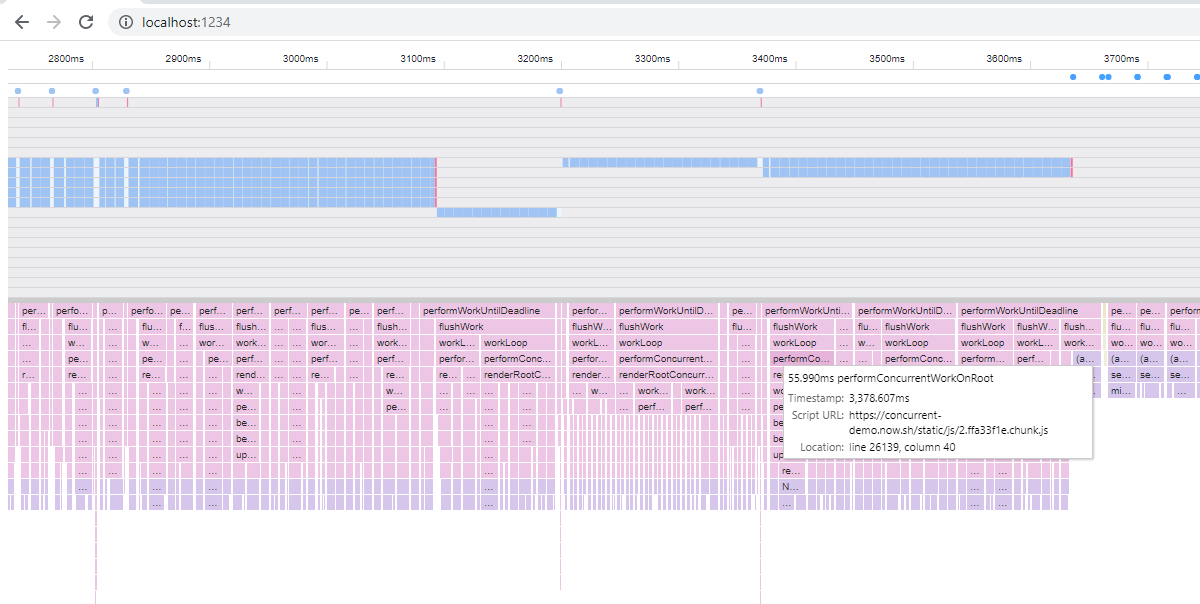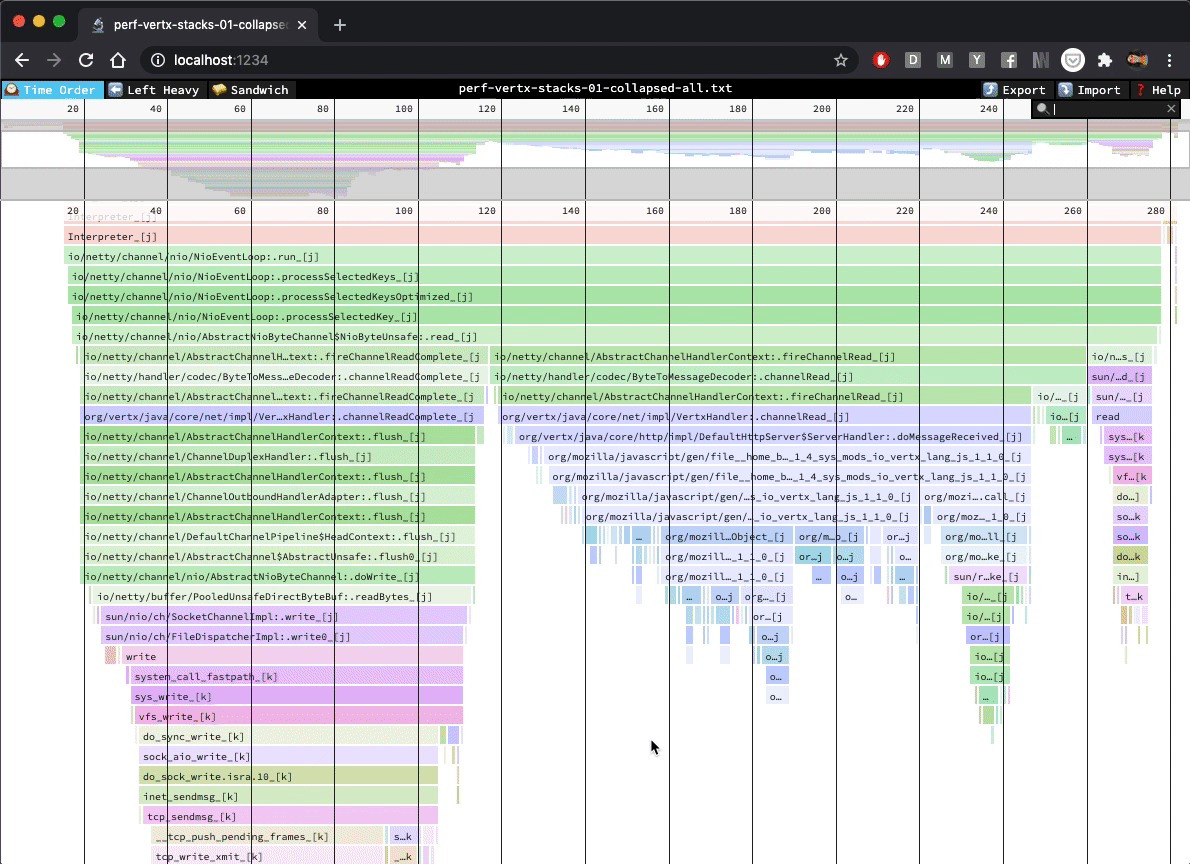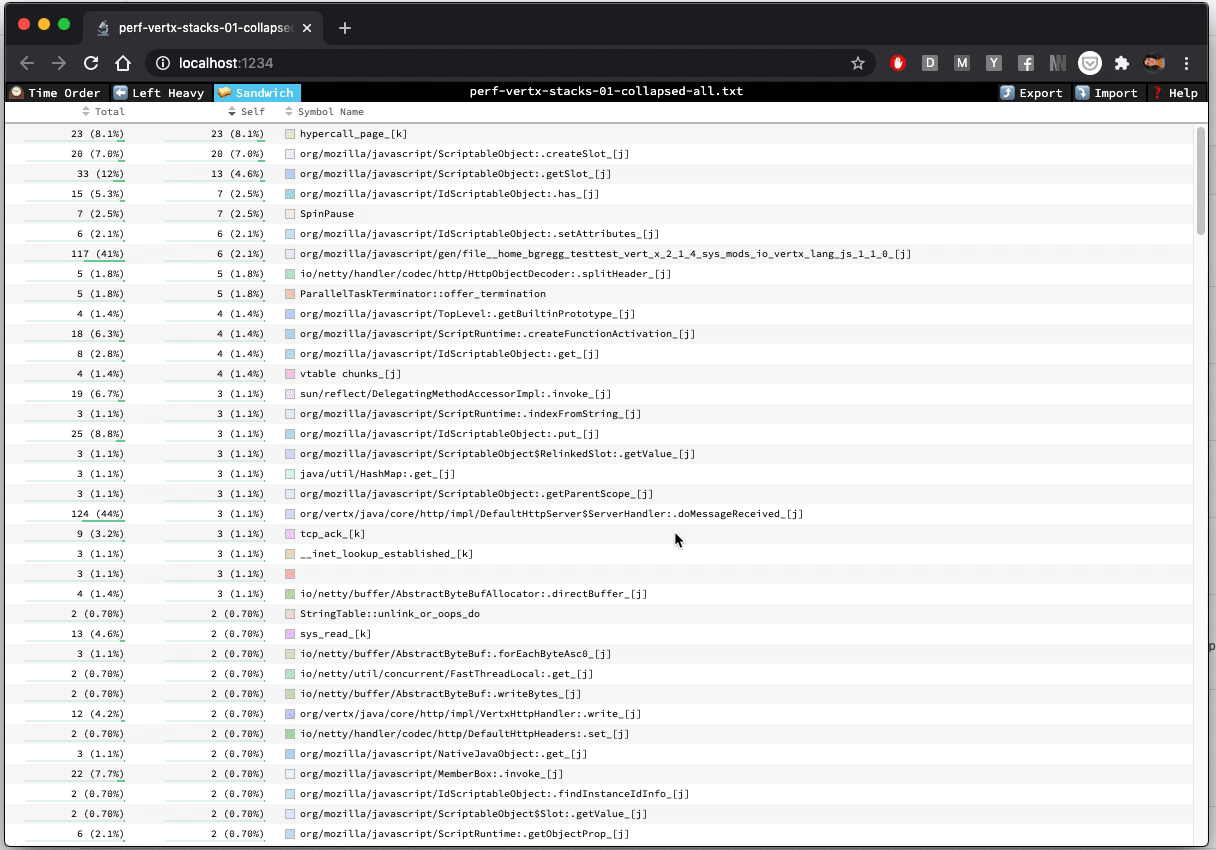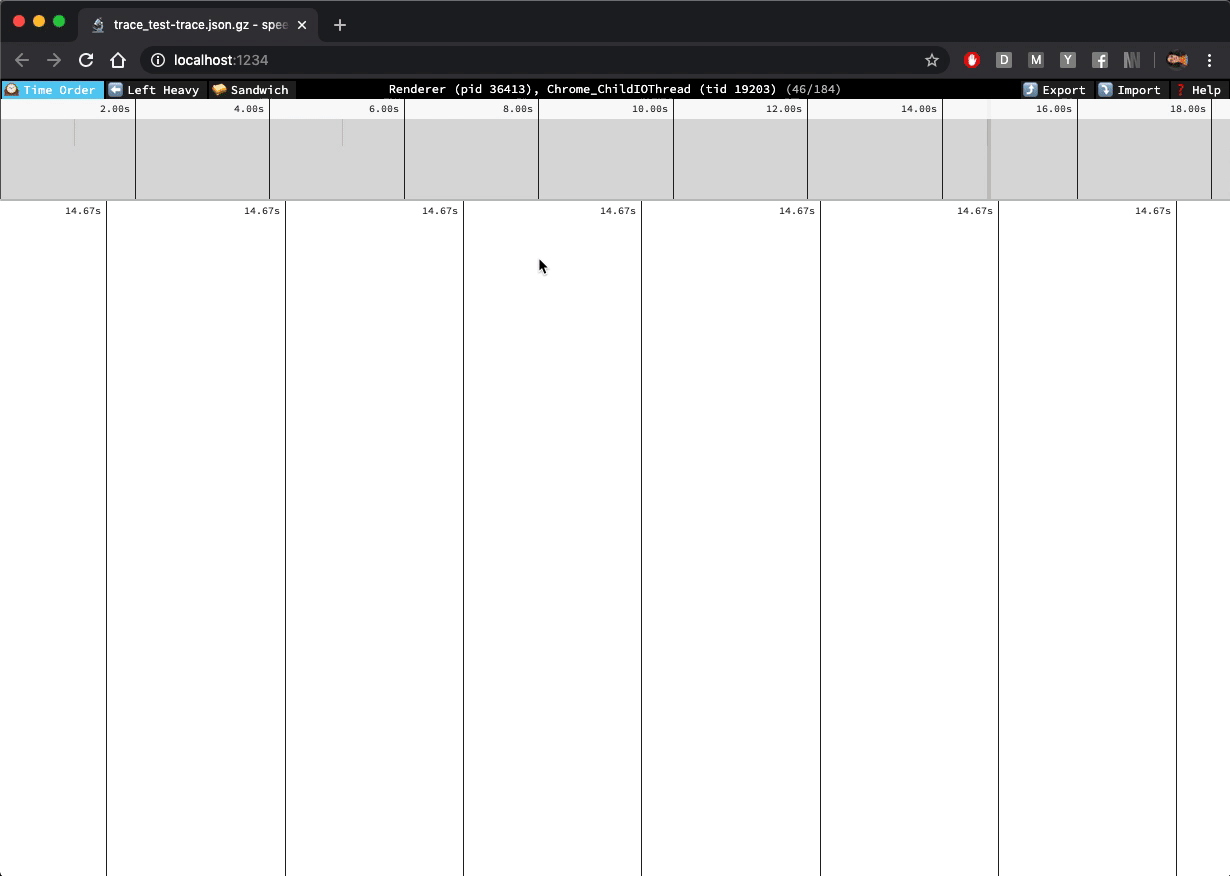Before this PR, we blindly assumed that all text imported into speedscope was UTF-8 encoded. This, unsurprisingly, is not always true. After this PR, we support text that's UTF-16 encoded, with either the little-endian or big-endian byte-order-mark.
Fixed#291
Closes#294
This adds import for Safari/webkit profiler. Well, for Safari 13.1 for sure, I haven't done any work to check if there's been changes to the syntax.
It seems to work OK, and is already a huge improvement over profiling in Safari (which doesn't even have a flame graph, let alone something like left heavy). Sadly, the sampler resolution is only 1kHz, which is not super useful for a lot of profiling work. I made a ticket on webkit bug tracker to ask for 10kHz/configurable sampling rate: https://bugs.webkit.org/show_bug.cgi?id=214866
Another thing that's missing is that I cut out all the idle time. We could also insert layout/paint samples into the timeline by parsing `events`. But I'll leave that for another time.
<img width="1280" alt="Captura de pantalla 2020-07-28 a las 11 02 06" src="https://user-images.githubusercontent.com/183747/88643560-20c16700-d0c2-11ea-9c73-d9159e68fab9.png">
## Context
Hi! I'm working on an experimental React [concurrent mode profiler](https://react-scheduling-profiler.vercel.app) in partnership with the React core team, and we're using a [custom build of Speedscope](https://github.com/taneliang/speedscope/compare/master...taneliang:fork-for-scheduling-profiler) that exposes Speedscope's internals to support our custom flamechart rendering. Specifically, Speedscope is used to import and process Chrome profiles, which are then fed to our rendering code that draws everything to a canvas.
Here's a screenshot of our app for context. The stuff above the thick gray bar is React data (some React Fiber lanes, React events, and other user timing marks), and a flamechart is drawn below.

## Problem
Early on, we had [an issue](https://github.com/MLH-Fellowship/scheduling-profiler-prototype/issues/42) where our flamechart was not aligned with the React data. The discrepancy between the flamechart frames and our React data grew over the time of the profile.
We tracked down the cause to https://github.com/jlfwong/speedscope/pull/80, which resolves https://github.com/jlfwong/speedscope/issues/70. It seems like zeroing out those negative time deltas resulted in the accumulation of errors over the time of these profiles, which resulted in the very visible misalignment in our profiler.
I am confident that the React data's timestamps are correct because they are obtained from User Timing marks, which have absolute timestamps and are thus independent of any `timeDelta` stuff. This would mean that Speedscope is likely displaying incorrect timestamps for Chrome profiles.
## Solution
This PR takes a different approach to solving the negative `timeDelta` problem: we add a `lastElapsed` variable as a sort of backstop, preventing `elapsed` from traveling backwards in time, while still ensuring that `elapsed` is always accurate.
We've been using this patch in our custom build for about a month now and it seems to work well.
This implements the next step towards full featured search in speedscope: visual highlighting of matching search results in the time ordered & left heavy views. This doesn't yet add the ability to click prev/next to select the next matching element in the editor, but I'm still planning on doing something like that. I haven't figured out yet what I want the user experience to be like for that.

This works towards fixing #38
This fixes two unrelated problems which together caused performance issues in the sandwich view & made hover tooltips appear to be broken.
The first issue was caused by continuously priming the `requestAnimationFrame` loop when it should be a no-op, and the second issue was caused by using different cache keys when trying to access a memoized value in the caller & callee flamegraph components. This resulted in thrash, and especially bad performance because the cache miss was resulting in us re-allocating the WebGL framebuffer on every frame, which is unsurprisingly quite slow.
Fixes#212Fixes#155Fixes#74 (though this was maybe already fixed)
This is the first step towards fixing #38.
I started with the easiest part from a UI-paradigm perspective, and also the place that's the most confusing that search doesn't work. Before this PR, browers' Cmd+F/Ctrl+F would *look* like it worked in the Sandwich view, but they wouldn't work fully because the view in the sandwich view is a virtualized table, meaning that it doesn't put all of the rows in the DOM. Instead, it only renders enough to fill the viewport to make rendering much faster.
Here's what the changes from this PR look like in action:

Before closing #38, I'll be adding search functionality to the flamechart views too.
This adds much better UI for selecting different profiles within a single import.

You can now hover over the middle of the toolbar or hit `t` on your keyboard to bring up the profile selector. From there, you can use fuzzy-find to switch to the profile you want, and hit "enter" to select it. The up and down arrow keys can be used while the profile selector filter input is focused to move through the list of profiles.
I think the "next" and "prev" buttons are now totally useless, so I removed them.
Fixes#167
Profile switching was subtly broken because action creators weren't being correctly re-bound due to a missing dependency in a `useCallback` call.
I also tried to reduce boilerplate in this PR by adding additional exhaustive deps protection via eslint for `useSelector`, `useAppSelector`, and `useActionCreator`. The removes the need for using `useCallback` or each of those.
Fixes#280
To test this, load a profile, then save a `.tsx` file locally. Before this change, it would bring you back to the welcome screen after hot reload. After this change, application state is still displayed. This is because before the change, the `setGLCanvas` action wasn't resulting in a re-render because it occurred between the initial render and the `useLayoutEffect` callback.
Fixes#276
I'd like to try writing new components using hooks, and to do that I need to upgrade from preact 8 to preact X.
For reasons that are... complicated, in order to upgrade without breaking part of my build process, I had to remove the dependency on `preact-redux` altogether. This led me to write my own implementation, and as part of that I realized I could remove `createContainer` in favour of some simple hooks that use redux.
Before landing:
- [x] Investigate performance issues in the sandwich views
- [x] Investigate es-lint checks for exhaustive hook dependencies
Fixes#268
I fixed it by dropping the dependency on quicktype entirely, and using its dependency directly. I still don't understand why the version of typescript used in this repository affects what quicktype is doing, but it seems like the issue is in quicktype, not its dependency.
I validated this change was correct by diffing the output of `node scripts/generate-file-format-schema-json.js` with what's currently on http://speedscope.app/file-format-schema.json. There's no difference.
This PR also includes changes to the CI script to ensure that we can catch this before hitting master next time.
@JustinBeckwith pointed out in #262 that `npm install` was broken in node 13.x, and @DanielRuf pointed in #254 that test fail for node 11+ because of a change to stability of sorting.
This PR seeks to address both of those.
The installation issue was fixed by just regenerating `package-lock.json` without needing to bump any of the direct dependency versions. The test failure issue requires manual intervention.
To fix the sort stability issue, I updated the tests to use the stable sort values (these were all the correct values, though some of the test values were incorrect).
To make the suite still pass for node 10, I added a hack where I override `Array.prototype.sort` with a stable implementation that's *only* used in tests (See comments in code for a justification for why)
## Test Plan
Before this PR: `npm install` on node 13.x fails & `npm run jest` results in test failures
After this PR: `npm install` on node 13.x passes & `npm run jest` passes for node 10, 12, and 13.
I ended up in a horrible peer dependency hell and apparently needed to bump the versions of quicktype, typescript, ts-jest, *and* jest to get out of it. But I think I got out of it!
Local builds and deployment builds both seem to work after these changes.
The code to import trace formatted events intentionally re-orders events in order to make it easier at flamegraph construction time to order the pushes and pops of frames.
It turns out that this re-ordering results in incorrect flamegraphs being generated as shown in #251.
This PR fixes this by avoiding re-ordering in situations where it isn't necessary.
Apparently Emscripten now generates `.symbols` files where names are not mangled using Clang's mangling scheme, but rather hex-escaped! So 'a\20b' means 'a b'. Currently we can't import these symbol maps into Speedscope because a regex rejects them, and they look weird because we don't unescape.
This PR introduces support for importing JSON based profiles that are missing a terminating `]` (and possibly have an extraneous `,`).
This is similar to #202, but takes a much more targeted and simple approach.
I'm confident that this approach is sufficient because this is exactly what `chrome://tracing` does: 27e047e049/tracing/tracing/extras/importer/trace_event_importer.html (L197-L208)Fixes#204
In #194, I added code to support import of multithreaded profiles from Chrome 70. I'm now doing some profiling work on an older version of Android chrome, and it seems like the profile objects don't yet have `id` properties. Instead, we should try using the `pid/tid` pair to identify profiles when the `id` field is absent.
This was tested against a profile import from Android Chrome 66.
this's will lack `com.apple.xray.owner.template` in instruments archive data where run instruments with command line.
like:
1. run`instruments -t Template.tracetemplate -D demo.trace -l 10000 -w test.app`
2. drag `demo.trace` into `https://www.speedscope.app`
3. alert `Unrecognized format! See documentation about supported formats`